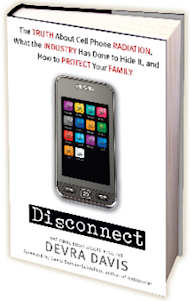 |
 |
|
 |
 |
About Us | Contact |
|
|
13/10/2010 - Disconnect: The Truth About Cell Phone RadiationDisconnect: The Truth About Cell Phone Radiation -
|
 |
The companies seem to be trying to cover their backs against possible future legal claims. If you are a phone user, are you aware of the sort of warnings hidden away in the depths of the user manuals? Do you carry your phone in a pocket or in a belt or other pouch? Deep inside the instruction manual of the iPhone is a warning to keep it "at least 15 mm away from the body" when "using iPhone near your body for voice calls or for wireless data transmission over a cellular network" and when using audio "with the dock connector pointed down towards your shoulder to increase separation from the antenna". Motorola advise keeping a distance of at least 25 mm (1 inch) between your body and the handset of many of their mobile phones as do Blackberry. Just as ignorance of the law does not protect you from prosecution, you should know that it is your duty to read the user manual before using your new phone.
The user-manual warnings should be far more prominently located in the "starter guide"/"Getting started section" and not just left in the detail that hardly anyone reads much later in the manual. As many children as young as 8 year-olds now have their own mobile phone; 'safe mobile phone use' should be taught and discussed in school lessons.
Roger Coghill, Chris Busby and I (Alasdair Philips) took the industry to a UK Court to require warning labels on all handsets back in 1998. We lost. It received international news coverage at the time.
Effective reasonable warnings and education are at the core of many of my frustrated discussions with senior Department of Health and HPA people to do with the fact that "safe mobile phone practice" should be required to be taught in schools in the UK. We should agree a formal core teaching unit that should be used as the basis of the lessons in every school - increasing in complexity as the children get older. At present the topic is discouraged in schools and the HPA are very mealy-mouthed about any 'precautionary use advice' regarding child use of mobile phones.
Cell phone radiation exposure is a world-wide potential catastrophe with, for most of us, a very long latency period before we have to face the consequences. A brain tumour, the start of which is initiated now in your or your child's head, will probably take between 20 to 30 years to become invasive enough to be diagnosed. Every time they make or take that mobile call they increase the chance of causing the cancer to start - every next call may be the one that does it and then you will just have to wait for the surgery, radiotherapy, chemotherapy and hope.
 |
Dr Davis believes children are "growing up in an unprecedented flood of radio frequency signals". She says they should only use mobile phones in emergencies. "The dangers for children are not definitively proven but do we really want to risk it?" How would you feel if you later on found out that you had actually paid for your child to have a device that gave them brain cancer?
With mobile phone use soaring, especially among the young, Dr Davis says we could face a "global public health catastrophe" if the problem is ignored. She says: "It is possible that the pervasive use of mobile phones is causing a host of subtle, chronic health problems, damaging our ability to have healthy children and creating long-term risks to our brains and bodies." Half the world's four billion cell phones are currently used by people under twenty.
The lack of "conclusive" evidence has allowed the industry and governments to claim phones are safe and has led to sceptics being dismissed as scaremongers. The wireless communications industry in its various forms is one of the few current "boom" industries, bringing in billions of profit to industry and tax to governments each year. Neither want a problem with this lucrative replacement for alcohol and tobacco revenue streams. Dr Davis says at least two senior scientists who work for mobile phone companies told her they were "deeply concerned" about the health risks. She said the debate has been distorted by a "show me the bodies" approach to evidence. The absence of an epidemic right now is not a cause for great relief or re-assurance that all is safe.
Almost every environmental toxin has had a sales/use life of at least 20 to 40 years before significant restrictions on use are introduced. On other Powerwatch pages you will find plenty of evidence of adverse effects reported in the scientific literature. It is rare to get "conclusive" evidence for health effects in the general population as we are so different in our biological and life responses. However, we believe that there is enough evidence now to be almost certain that microwave exposure from modern telecommunications systems is damaging some people.
The most troubling research, Davis says, threatens male fertility. Research around the world, including in the US, China and Australia, suggests that keeping a switched-on mobile in a trouser pocket can have a drastic effect on sperm. "All the research shows the same thing - if you take young men who are trying to become fathers, those who use mobile phones at least four hours a day have about half the sperm count of others," says Dr Davis. "Sperm exposed to mobile phone radiation in the lab is sicker, thinner and less capable of swimming."
Many men who carry handsets on their belt or in their pockets do so with the face and keypad facing outwards - leaving the antenna (which is always at the back of the handset) facing their body when it has to power-up to full power (1000 times stronger that the lowest power the handset can transmit at) in order to make a good connection with the nearest base station. In doing so it sends high SAR power into the trunk and towards the kidneys and liver (testicles if in a trouser pocket).
Note: The highest exposure at these times often comes from the phone when on standby, when it logs in almost always at full power and it is internal measurements of the received signal levels of this exchange between handset and base-station that sets the future level to be used for calls.
The handset should always be carried with the rear facing away from the body - that helps direct the microwaves way from the body and also allows the phone to work at levels hundreds of times lower than if the phone is held the other way around. This effect has got worse with modern phones and their antennas are more directional in order to lower head SARs when held to the ear in normal use.
Some girls carry them in chest bags which hang just below their breasts. Breasts, eyes and testicles absorb external microwave energy the most. Internally, blood rich organs (liver, kidneys, heart) are among the top energy absorbers.
The ovaries and foetus are relatively well protected by the trunk, but it obviously makes sense to keep the handset away from those areas, especially the foetus in the first six months of gestation. Many later-life causes of ill health are increasingly being recognised as having their roots in foetal exposure to chemicals, hormones, radiation (of various sorts). It makes sense for the manufacturers to warn about the need to minimise such exposure.
Most handsets also put out pulsed ELF magnetic fields from the battery current pulses and those travel much further into the body than the microwave signals. ELF magnetic fields are significantly associated with childhood leukaemia and some adult cancers. So it is good to keep the handset away from the female abdomen. I would not have thought that many women carried their mobiles near there, unless in a belt "bum-bag"/"waist-bag" carried at their front. I see that some such bags even have a special mobile phone handset pocket. I don't know how popular such bags are nowadays. Pregnant women carrying a phone in standby mode in a handbag may expose the foetus to high levels of radiation if there is a specific mobile phone pocket next to the abdomen.
Mobile phones in standby mode will transmit high levels of microwaves frequently if the signal strength is poor - such as for example in a tube station or train. The person with the phone will be unaware of the frequent emissions as the phone attempts to find a stronger signal source.
"Low SAR" mobiles:
The USA FCC has just revised its advice and says that choosing a low SAR (Specific Absorption Rate - the amount of energy that is deposited in your body) handset is not a safety advantage. Surprisingly I agree with the FCC. I have long thought that peak SAR was a misleading "red herring".
Some of the lowest peak-SAR phones actually emit a higher total SAR into brain tissue than the much higher peak-SAR handsets - it is just spread out a lot more through the brain tissue. Generally low SAR phones are less efficient at getting their signals out to the base station and so regularly work at a much higher transmit power to compensate. Peak-SAR (the thing used for SAR rating) is just the highest value recorded when the handset is working at maximum power. It does not represent in any way the total SAR into your brain.
Handsets have a power-control range of over 1000-fold in the power they transmit - they are told what power they need to transmit at by the base-station during the start of the phone call when the handset works at full power for the measurement to take place. Efficient handsets then turn their power down often by over 100-fold!
Choosing a low peak-SAR handset was really a diversionary exercise by the "thermal effects only" brigade, in my opinion. It missed the point of non-thermal concerns completely. If the problem of brain cancer or other effects turns out to be non-thermal effects, then all handsets have a problem and choosing a low SAR handset will not help and might, in fact, be worse.
 |
** Disconnect is published in the UK at the start of November 2010.
ISBN 9780525951940, available from Turnaround UK and all good bookshops, price £18.99 hardback.
Dr Devra Davis is giving a lecture in London on "The Toxicology, Epidemiology and Exposure Assessment of Mobile Phones -- data gaps and research priorities" on Tuesday 2nd November at 5.15
for an hour with Q & A. The audience will be primarily researchers, students and academics, but anybody can attend free of charge.John Snow Lecture Theatre, Main building, London School of Hygiene & Tropical Medicine, Keppel Street, London, WC1.
Ways to reduce your exposure when using and carrying a mobile phone
Although we don't usually mention products, we do suggest that users:
(a) consider using air-tube hands-free sets available from various suppliers in the UK as various makes e.g.(Smart and Safe, air2hear, Bluetube) and keeping the handset away from your body, or
(b) use the very practical and effective screening pouches available from EMFields. These have excellent screening material on one side of the pouch and are an easy way to both carry and use (normally or with hands-free) a mobile phone whilst reducing the absorbed radiation (SAR) by over 90%/

